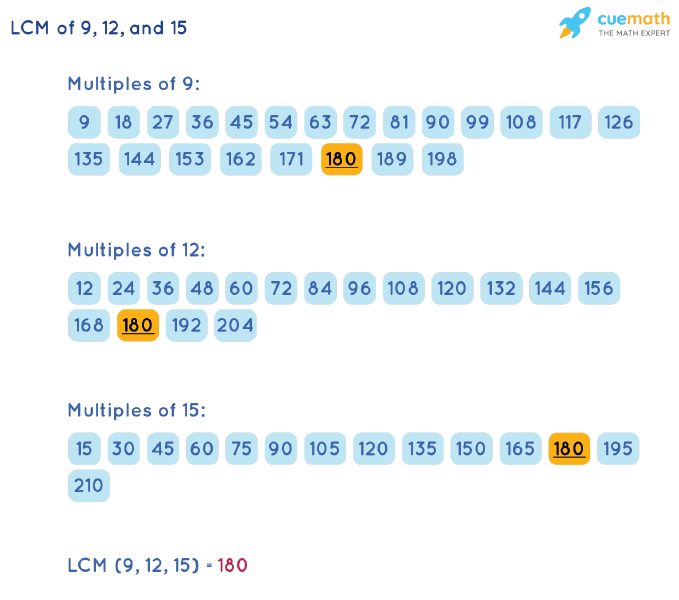Have you ever been faced with a puzzle that seemed impossible to crack, leaving you scratching your head in frustration? Finding the Least Common Multiple (LCM) of two seemingly simple numbers, like 15 and 9, might feel like a similar challenge. But fear not! The seemingly complex world of LCMs can be demystified, revealing a fascinating concept with real-world applications that you might not expect. Just like piecing together a puzzle, we’ll break down the process step-by-step, revealing the hidden beauty of mathematics and its everyday relevance.

Image: www.teachoo.com
The Least Common Multiple (LCM) is essentially the smallest number that is divisible by both numbers in question. Imagine you’re baking cookies for a party, and you need two types of dough – one requiring 15 minutes of baking time and the other requiring 9 minutes. To get both types of cookies done at the same time, you need to find the LCM of 15 and 9. Our quest to find the LCM of 15 and 9 isn’t about simply crunching numbers, it’s about unlocking a fundamental concept used in areas as diverse as scheduling appointments to measuring ingredients in a recipe. So, let’s delve into the exciting world of LCMs, unraveling the mystery of finding the LCM of 15 and 9.
Diving Deeper: Unpacking the Least Common Multiple (LCM)
Before we embark on our journey to uncover the LCM of 15 and 9, let’s understand what LCM truly represents. The Least Common Multiple (LCM) of two numbers is the smallest possible number that is a multiple of both. Imagine two runners starting at the same point on a circular track. One runner completes a lap every 15 minutes, while the other completes a lap every 9 minutes. The LCM represents the moment when both runners will be back at the starting point together.
To find the LCM, we have a few methods at our disposal, each with its own unique approach:
-
Listing Multiples: This method involves listing out the multiples of both numbers until we find the smallest common multiple. For example:
- Multiples of 15: 15, 30, 45, 60, 75, 90, …
- Multiples of 9: 9, 18, 27, 36, 45, 54, 63, 72, 81, 90, …
As we can see, the smallest common multiple of 15 and 9 is 45.
-
Prime Factorization: This method breaks down both numbers into their prime factors, then multiplies the highest power of each prime factor present in either number. Let’s break down 15 and 9:
- 15 = 3 x 5
- 9 = 3 x 3
The highest power of 3 is 3² (3 x 3) and the highest power of 5 is 5¹. Therefore, the LCM of 15 and 9 is 3² x 5 = 45.
-
Using the Greatest Common Factor (GCD): This method leverages the relationship between the LCM and the Greatest Common Factor (GCD). The GCD of two numbers is the largest number that divides both without leaving a remainder. The product of the LCM and GCD is equal to the product of the two original numbers. So, to find the LCM:
- GCD (15, 9) = 3
- LCM (15, 9) = (15 x 9) / 3 = 45
Beyond the Classroom: Applications of the LCM in Everyday Life
Finding the LCM might seem like a purely mathematical exercise, confined to the walls of a classroom. But its applications extend far beyond the textbook, impacting our daily lives in ways we might not even realize.
-
Scheduling and Time Management: Imagine you’re trying to schedule meetings with two clients. One client is available every week on Mondays and Wednesdays, while the other client is available every Tuesday and Thursday. The LCM can be used to find the earliest date when both clients will be available for a meeting simultaneously.
-
Music and Rhythm: In music, the LCM plays a crucial role in defining the least common multiple of different time signatures, helping musicians create harmonious rhythms and melodies that complement each other.
-
Construction and Design: Architects and engineers use LCM calculations to synchronize and optimize the construction process, ensuring that different parts of a structure are constructed in sync, preventing costly delays.
-
Sports and Competition: The LCM comes into play in sporting events when determining the shortest distance at which two runners will cross the finish line together.
Mastering LCM: Tips and Tricks for Success
Now that we’ve explored the depths of LCM and its diverse applications, let’s equip ourselves with practical tips and tricks to master the art of finding the LCM:
-
Start with the Basics: A strong foundation in basic arithmetic is crucial for understanding and calculating LCMs. Ensure you’re comfortable with multiplication, division, and prime factorization.
-
Use Prime Factorization: For larger numbers, prime factorization offers a streamlined approach to finding the LCM. Break down the numbers into their prime factors, then multiply the highest power of each factor.
-
Practice Makes Perfect: Like any skill, proficiency in finding the LCM comes with practice. Work through various examples, gradually increasing the complexity of the numbers involved.

Image: www.cuemath.com
Lcm For 15 And 9
Conclusion: The Power of Understanding the LCM
Unveiling the mystery of the LCM has opened a door to a fascinating world of mathematical concepts with real-world implications. From scheduling appointments to optimizing construction projects, the LCM is a powerful tool that simplifies our lives and drives efficiency. Whether you’re a student grappling with math problems or an individual navigating the complexities of daily life, understanding the LCM empowers you to tackle challenges with a fresh perspective. So, the next time you encounter the concept of LCM, remember that it’s not just an abstract mathematical equation; it’s a powerful tool shaping our world, waiting to be explored and harnessed.





